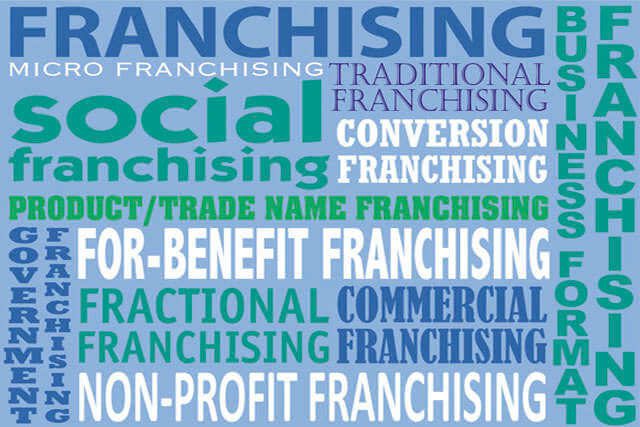This article intends to provoke discussion around ways in which the social and micro franchising communities of practice can organize and compare information and ideas so that the field of practice can advance more rapidly.
By Julie McBride, Senior Consultant, Social Franchising, MSA Worldwide
Getting on the Same Page
Put simply, franchising is a method of replicating a proven business. Franchising has two main forms. In Product/Trade Name Franchising (Traditional Franchising), a franchisor owns the right to a name or trademark, licenses the right to use that name or trademark, and generally provides the franchisee with a product that needs pre- and post-sales service.
Business Format Franchising involves a more complex relationship in which the franchisor provides franchisees with a full range of services and support, and the franchisee operates according to the franchisor’s standards in delivering the branded products or services to consumers.
While Traditional Franchising is larger is total sales, Business Format Franchising has become one the most widely used methods for expanding the distribution of proven business concepts (Alon, 2014). There are now hundreds of industries using franchising to distribute products and services including restaurants, hotels, cleaning services, fitness centers, assisted living, and home health care.
According to the IFA, franchising is growing rapidly overseas with more than 400 U.S. franchise systems operating internationally. There is also an emergence of marginalized segments of society, particularly women and minorities, operating franchise businesses. Franchising is a desirable growth strategy to the concept owner because it allows them to grow at a high rate while maintaining brand standards. It also reduces the amount of growth capital that the franchisor must raise. Franchisees benefit from gaining access to proven concepts and business systems, and because most franchisors offer ongoing training and support and in some cases financing assistance, franchising provides a way to overcome the most common obstacles to starting a business – lack of business experience, and insufficient start-up capital (Harrington, 2013).
Franchising has taken many forms over the years as it has adapted and evolved to meet changing market needs. Social and micro franchising are the latest concepts in franchising, and interest in using them to deliver benefits to underserved communities in both developed and developing economies is gaining momentum (Alon, 2014).
The purpose of this article is to provoke discussion around ways in which the social and micro franchising communities of practice can organize and compare information and ideas so that the field of practice can advance more rapidly. This article will be followed by a series of case studies that highlight lessons learned about the different types of models, and circumstances where each would be appropriately adapted.
Overcoming a Critical Obstacle to Progress
As new model variations emerge, there is a need to understand their effectiveness and applicability to different contexts so that they can be replicated appropriately. However, the field of social franchising is growing so haphazardly that it is challenging to capture best practices and lessons learned, let alone use them to advance the field. It is, therefore, difficult for stakeholders to make informed decisions about franchise design and investment. The result is that funding is not always channeled to effectively designed franchise systems.
When poorly designed and/or executed franchises are assessed and compared without understanding how they are fundamentally flawed or different from each other, erroneous conclusions are drawn about the effectiveness of franchising as a business model (as opposed to the effectiveness of the organization attempting to use the business model). As a result, funds for social franchising, in general, could be reduced or discontinued and end up unnecessarily shortening the lifespan of a model that has tremendous potential to improve people’s lives.
The first step to solving the challenges ahead is not as sexy as the title of this article suggests. It is simply a matter of defining, identifying, and differentiating between the various “shades,” or variations, of franchising. Once that is done, a social and micro franchise community of practice can work more productively together using a common understanding and language around franchising.
Looking a Little Closer: Variations of Franchise Models
There are several variations of franchise models. Those that matter most to the social franchise community are defined in Box 1 below:
| Box 1: Definitions of Commonly Used Franchise Models
Franchise: A relationship, as defined by the FTC and various states, which typically includes three basic elements: (1) the granting of the right to use the systems mark, (2) substantial assistance or control provided by the franchisor to the franchisee, (3) the payment of a fee (in excess of $500) during a period of time six months before or six months following the commencement of the relationship. Traditional Franchise (aka “Product and Trade Name Franchise”): The licensing of a franchisee/dealer to sell or distribute a specific product using the franchisor’s trademark, trade name, and logo. (Automobile dealerships, Truck dealerships, Farm equipment, Mobile homes, Gasoline service stations, Automobile accessories, Soda, Beer, Bottling are types of traditional franchising. In traditional franchising, the franchisee generally is required to provide presale or post-sale services of the franchisor’s products. Describes the specific product or service associated with the delivery, not the system of delivery as in Business Format Franchising.). Fractional Franchise: The products or services being franchised are housed within an existing business and contribute to only a portion of overall revenues. Business Format Franchising (BFF): A franchise occurs when a business (the franchisor) licenses its trade name (the brand) and its operating methods (its system of doing business) to a person or group (the franchisee) that agrees to operate according to the terms of a contract (the franchise agreement). The franchisor provides the franchisee with support and, in some cases, exercises some control over the way the franchisee operates under the brand. In exchange, the franchisee usually pays the franchisor an initial fee (called a franchise fee) and a continuing fee (known as a royalty) for the use of the trade name and operating methods. BFF describes the system of delivery, not the specific product or service associated with the delivery as in Product or Trademark Franchising. Social Franchise: The application of commercial franchising methods and concepts to achieve socially beneficial ends” (International Franchise Association’s Social Sector Task Force, 2014). Social Franchising is used to increase access to products and services across a range of socially oriented industries (e.g., education, health, agriculture, water, sanitation, clean energy), with its target market being underserved populations in low, medium, and high-income countries around the globe (MSA Worldwide). Micro Franchise: A small business whose start-up costs are minimal and whose concepts and operations are easily replicated (Fairbourne et. al, 2006). Micro-franchising is used to increase access to business opportunities that enable people to lift themselves out of poverty. Its primary purpose is economic development and unlike social franchising, it is not necessary that the business being franchised meet consumer social needs (MSA Worldwide). Hybrid Social/Micro Franchise: A micro franchise of a business that delivers social benefits to consumers. |
What all of these models have in common is that they offer franchisees a brand and products that represent value to the consumer. Fractional and business-format models offer services in addition to products. Because service delivery relies on human behavior, maintaining standards across the network for these models requires more inputs such as training and ongoing support from the franchisor.
A rigorous compliance system is also required to maintain control over the brand. As the franchise becomes more central to the franchisee’s business success, the franchisor will have more control over franchisee quality and consumer brand perception. This is because franchisees value the franchise offering enough to deter them from behaving in ways that would risk losing franchise rights.
Fractional franchises, where only a portion of the franchisee’s business is dependent upon support from the franchisor, are more difficult to control and require much greater effort on the part of the franchisor to maintain service standards. Further, it is doubtful in a social franchise that the franchisor will be able to recover a significant portion of operating costs through franchise fees or royalties and thus achieve sustainability when the financial value-add to the business is small or even unmeasurable, as is the case with most fractional social franchises. While these are significant potential pitfalls of fractional franchising, the model does meet the needs of social franchisors in terms of reducing the amount of start-up capital required – since the model is adding to existing businesses rather than creating new ones (Alon, 2014).
Figure 1, below, provides a high-level overview of each model’s features and the complexity of the franchisor/franchisee relationship in terms of their roles and responsibilities to each other. Knowing the differences will help stakeholders understand why different models out-perform each other in different ways and help them select models that are suited to achieving their goals.
Figure 1. Defining and Differentiating Features of Common Franchise Models
|
Model Features |
Model Type |
||
|
Traditional |
Fractional |
Business-format |
|
| Franchisor roles and responsibilities | |||
| Brand |
X |
X |
X |
| Marketing support |
X |
X |
X |
| Supply chain |
X |
X |
X |
| Service delivery guidelines (for technical aspect of business) |
|
X |
X |
| Full business operating system |
|
|
X |
| Training (for technical aspect of business) |
X |
X |
X |
| Training (for business operations) |
|
|
X |
| Support (for technical aspect of business) |
X |
X |
X |
| Support (for business operations) |
|
|
X |
| Start-up financing assistance |
X |
|
X |
| Franchisee roles and responsibilities | |||
| Infrastructure (leasing/purchasing space from which to conduct the franchise business) |
X |
||
| Licensing fees/royalties |
X |
X |
X |
| Compliance rules (for technical aspect of business) |
X |
X |
X |
| Compliance rules (for business operations) |
X |
||
| Capital |
X |
||
The Devil Is in the Details
This article presents a hypothesized way to categorize and differentiate between the most commonly seen variations of franchise models to date. Figure 1 shows that there are multiple ways to configure the three different models of franchising (traditional, fractional, and business format) in order to achieve different outcomes. What differentiates the sectors and the model variations (i.e., micro, social, hybrid) are the intended stakeholder benefits. Key stakeholders in franchising include the end users of the product or service being franchised (consumers); the individuals who own and operate the franchised businesses (franchisees); the entity that owns and operates the franchise system (the franchisor); and the individuals helping to finance the business through investments, loans, or donations. Depending on the purpose of the franchise, there are two ways that a stakeholder could benefit – financially/materially or socially.
Figure 2. Differentiating Features of Franchise Model Variations
2a. Business Model: Traditional Franchising (product without customer-facing service element)
|
Model Variation |
Stakeholder Benefits |
|||||||
|
Consumers |
Franchisees |
Franchisors |
Investors |
|||||
|
Material |
Social |
Financial |
Social |
Financial |
Social |
Financial |
Social |
|
| 1) Commercial |
X |
X |
X |
X |
||||
| 2) Government |
X |
X |
X |
X |
||||
| 3a) Not-for-profit: micro franchise |
X |
X |
X |
X |
||||
| 3b) Not-for-profit: social franchise |
X |
X |
X |
X |
||||
| 3c) Not-for-profit: micro / social hybrid |
X |
X |
X |
X |
X |
|||
| 4a) For-benefit-business: micro franchise |
X |
X |
X |
X |
X |
X |
||
| 4b) For-benefit-business: social franchise |
X |
X |
X |
X |
X |
X |
||
| 4c) For-benefit-business: micro / social hybrid |
X |
X |
X |
X |
X |
X |
X |
|
2b. Business Model: Fractional Franchising (service being franchised is housed in another business)
|
Model Variation |
Stakeholder Benefits |
|||||||
|
Consumers |
Franchisees |
Franchisors |
Investors |
|||||
| Material |
Social |
Financial |
Social |
Financial |
Social |
Financial |
Social |
|
| 1) Commercial |
X |
X |
X |
X |
||||
| 2) Government |
X |
X |
X |
X |
||||
| 3a) Not-for-profit: micro franchise |
X |
X |
X |
X |
||||
| 3b) Not-for-profit: social franchise |
X |
X |
X |
X |
||||
| 3c) Not-for-profit: micro / social hybrid |
X |
X |
X |
X |
X |
|||
| 4a) For-benefit-business: micro franchise |
X |
X |
X |
X |
X |
X |
||
| 4b) For-benefit-business: social franchise |
X |
X |
X |
X |
X |
X |
||
| 4c) For-benefit-business: micro / social hybrid |
X |
X |
X |
X |
X |
X |
X |
|
2c. Business Model: Business Format Franchising (standalone business being franchised)
|
Model Variation |
Stakeholder Benefits |
|||||||
|
Consumers |
Franchisees |
Franchisors |
Investors |
|||||
|
Material |
Social |
Financial |
Social |
Financial |
Social |
Financial |
Social |
|
| 1) Commercial |
X |
X |
X |
X |
||||
| 2) Government |
X |
X |
X |
X |
||||
| 3a) Not-for-profit: micro franchise |
X |
X |
X |
X |
||||
| 3b) Not-for-profit: social franchise |
X |
X |
X |
X |
||||
| 3c) Not-for-profit: micro / social hybrid |
X |
X |
X |
X |
X |
|||
| 4a) For-benefit-business: micro franchise |
X |
X |
X |
X |
X |
X |
||
| 4b) For-benefit-business: social franchise |
X |
X |
X |
X |
X |
X |
||
| 4c) For-benefit-business: micro / social hybrid |
X |
X |
X |
X |
X |
X |
X |
|
Figures 2a, 2b, and 2c show the key points of differentiation between the various franchise configurations regarding how each of the stakeholders stands to benefit from the franchise. For example, the factor that differentiates a micro franchise from a social franchise is in how consumers benefit. The product or service being micro-franchised fills a material need but not necessarily a social need at the consumer level, whereas a social franchise is designed to meet a social need at the consumer level. The societal benefit of a micro franchise is in the economic opportunity it provides to base-of-the-pyramid entrepreneurs at the franchisee level. A commercial franchise model also provides economic opportunities to entrepreneurs, but mostly to those at a higher level of the economic pyramid and who have access to start-up capital. A hybrid social/micro franchise would provide both social benefits to end users and economic benefits to franchisees.
Being able to objectively and systematically differentiate between the different models will make it easier for academics to conduct meaningful research, financiers to make better-informed investment decisions, and franchisors to make better design decisions.
Reaching a Consensus
The ideas presented in this article are meant to provoke discussion and debate that ultimately lead to consensus among stakeholders on how to define and differentiate between franchise models. Once there is agreement on definitions, the process of cataloging the current landscape of social franchises worldwide can begin. Finally, when there is a more accurate and complete record of social franchise practices, researchers can examine in greater detail the effectiveness of the models in various conditions.
Do you have further questions about social sector franchising?
MSA can provide expert guidance on how the model of social franchising can efficiently bring needed services to under-served populations.




